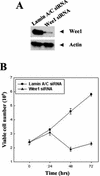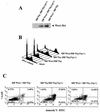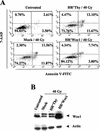Depletion of Wee-1 kinase is necessary for both human immunodeficiency virus type 1 Vpr- and gamma irradiation-induced apoptosis
- PMID: 12525641
- PMCID: PMC140938
- DOI: 10.1128/jvi.77.3.2063-2070.2003
Depletion of Wee-1 kinase is necessary for both human immunodeficiency virus type 1 Vpr- and gamma irradiation-induced apoptosis
Abstract
Human immunodeficiency virus (HIV) protein R (Vpr) induces G2 arrest, and prolonged G2 arrest leads to apoptosis. We find that in HeLa cells the cell cycle regulatory kinase, Wee-1, is depleted following prolonged G2 arrest induced by Vpr. Of note, small interfering RNAs directed to Wee-1 triggered apoptosis, suggesting a direct role for Wee-1 in apoptosis. In support of this hypothesis, overexpression of Wee-1 suppressed Vpr-mediated apoptosis. Importantly, similar results were observed with cells induced to undergo apoptosis gamma irradiation. Thus, Wee-1 may serve as a key regulator of both HIV type 1 Vpr- and gamma irradiation-mediated apoptosis and possibly serve as a general regulator linking the cell cycle to some pathways of apoptosis.
Figures







Similar articles
-
Increased levels of Wee-1 kinase in G(2) are necessary for Vpr- and gamma irradiation-induced G(2) arrest.J Virol. 2004 Aug;78(15):8183-90. doi: 10.1128/JVI.78.15.8183-8190.2004. J Virol. 2004. PMID: 15254189 Free PMC article.
-
HIV-1 Vpr induces G2 cell cycle arrest in fission yeast associated with Rad24/14-3-3-dependent, Chk1/Cds1-independent Wee1 upregulation.Microbes Infect. 2006 Oct;8(12-13):2736-44. doi: 10.1016/j.micinf.2006.08.003. Epub 2006 Aug 30. Microbes Infect. 2006. PMID: 16968670
-
Induction of M-phase arrest and apoptosis after HIV-1 Vpr expression through uncoupling of nuclear and centrosomal cycle in HeLa cells.Exp Cell Res. 2000 Aug 1;258(2):261-9. doi: 10.1006/excr.2000.4908. Exp Cell Res. 2000. PMID: 10896777
-
Partner molecules of accessory protein Vpr of the human immunodeficiency virus type 1.DNA Cell Biol. 2004 Apr;23(4):193-205. doi: 10.1089/104454904773819789. DNA Cell Biol. 2004. PMID: 15142377 Review.
-
HIV-1 VPR modulates cell cycle G2/M transition through an alternative cellular mechanism other than the classic mitotic checkpoints.Front Biosci. 2002 Feb 1;7:d349-57. doi: 10.2741/elder. Front Biosci. 2002. PMID: 11815283 Review.
Cited by
-
Human immunodeficiency virus type 1 Vpr binds to the N lobe of the Wee1 kinase domain and enhances kinase activity for CDC2.J Virol. 2008 Jun;82(12):5672-82. doi: 10.1128/JVI.01330-07. Epub 2008 Apr 2. J Virol. 2008. PMID: 18385244 Free PMC article.
-
The Vif accessory protein alters the cell cycle of human immunodeficiency virus type 1 infected cells.Virology. 2007 Mar 15;359(2):243-52. doi: 10.1016/j.virol.2006.09.026. Epub 2006 Oct 23. Virology. 2007. PMID: 17056089 Free PMC article.
-
Molecular insight into how HIV-1 Vpr protein impairs cell growth through two genetically distinct pathways.J Biol Chem. 2011 Jul 8;286(27):23742-52. doi: 10.1074/jbc.M111.220780. Epub 2011 May 12. J Biol Chem. 2011. PMID: 21566118 Free PMC article.
-
Human immunodeficiency virus-1 (HIV-1)-mediated apoptosis: new therapeutic targets.Viruses. 2014 Aug 19;6(8):3181-227. doi: 10.3390/v6083181. Viruses. 2014. PMID: 25196285 Free PMC article. Review.
-
Vpr Is a VIP: HIV Vpr and Infected Macrophages Promote Viral Pathogenesis.Viruses. 2020 Jul 27;12(8):809. doi: 10.3390/v12080809. Viruses. 2020. PMID: 32726944 Free PMC article. Review.
References
-
- Ayyavoo, V., A. Mahboubi, S. Mahalingam, R. Ramalingam, S. Kudchodkar, W. V. Williams, D. R. Green, and D. B. Weiner. 1997. HIV-1 Vpr suppresses immune activation and apoptosis through regulation of nuclear factor kappa B. Nat. Med. 3:1117-1123. - PubMed
-
- de Noronha, C. M., M. P. Sherman, H. W. Lin, M. V. Cavrois, R. D. Moir, R. D. Goldman, and W. C. Greene. 2001. Dynamic disruptions in nuclear envelope architecture and integrity induced by HIV-1 Vpr. Science 294:1105-1108. - PubMed
-
- Elbashir, S. M., J. Harborth, W. Lendeckel, A. Yalcin, K. Weber, and T. Tuschl. 2001. Duplexes of 21-nucleotide RNAs mediate RNA interference in cultured mammalian cells. Nature 411:494-498. - PubMed
Publication types
MeSH terms
Substances
Grants and funding
LinkOut - more resources
Full Text Sources
Molecular Biology Databases

